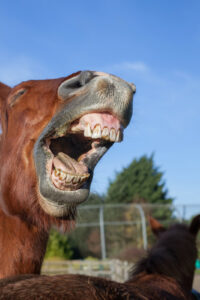Barks Blog
Found in Translation

Vocalizations are part of communication, and we have a pretty good idea of what it means when we hear a horse squeal, or a dog growl. But these are generalizations. Even vocalizations that seem to have one specific meaning (because they are often associated with one context), may actually have several. It gets even more complicated when we look at vocalizations that are used frequently.
There are different ways that a horse can neigh, and a dog can bark, just as there are different ways in which someone might say hello. And when we say things in different ways, they have different meanings. Just as there is context and nuance with body language, there is also context and nuance with vocalizations.
We should not be generalizing when we try to understand what an animal is saying or the emotions he is feeling. We need to actually understand the nuances of his language. This is more complicated, of course, because animals don’t speak.
While a person may say hello in several different ways to convey how they feel, they can also use other words to communicate their emotional state. But that one neigh of the horse and that one bark of the dog have to cover a whole range of meanings and convey an array of different messages.
(Issue 49, July 2021, pp.46-49). Read article
